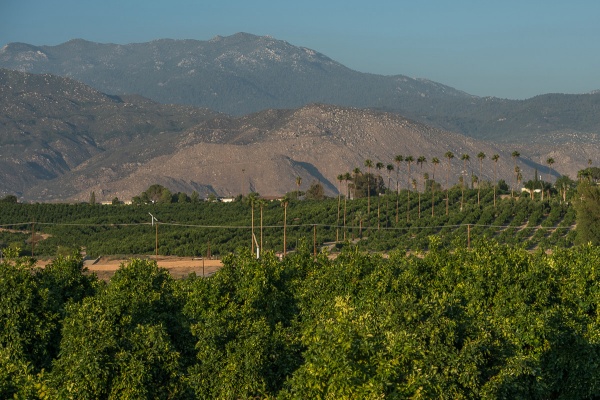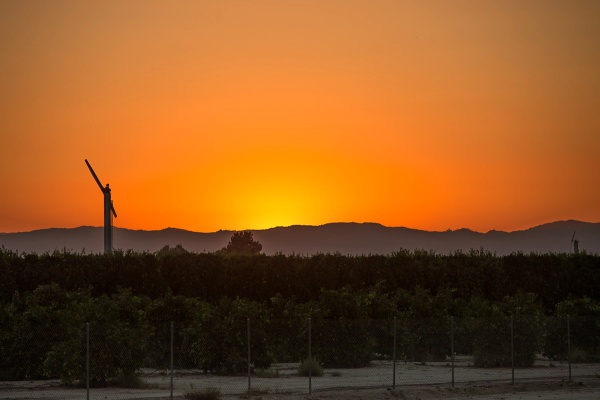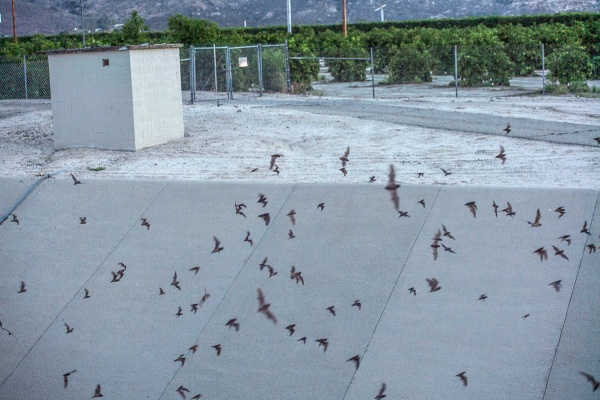One after another, cars arrive as if on cue. They pull over on the shoulder of this two-lane highway near an endless orange tree grove here in Valle Vista on the outskirts of Hemet in Riverside County.

Old couples, parents of small children and families with grown kids sheepishly exit their cars, wander to the chain-link fence at the Bautista Creek flood control channel (aka Bat Bridge) and eye the soon-to-be setting sun. “Have you been here before?” “Nope, it’s my first time.” “How about you?” “I have always meant to come out here and now I’m finally doing it.”
“I saw it last week when I was crossing another bridge and I didn’t know what it was. It scared me at first,” says one young woman who came with her older parents. “I did a little research and found out about them. That’s how I’m here tonight – to really see them.”
“They” are bats, Mexican free-tailed bats to be exact. Underneath this small bridge probably tens of thousands of the flying mammals are getting ready for their nights’ forage of insects, drawn to the sweet smell of orange.

Home to the largest bat colonies in the area, this nightly bat swarm is one of Southern California’s amazing natural wonders.
Valle Vista’s bats haven’t achieved the notoriety of Austin, Texas’ Congress Avenue Bridge (those too are Mexican free-tailers), and maybe that’s a good thing. The easy good-natured camaraderie of fellow bat watchers (some bring folding chairs and snacks), the unmarked location, the agricultural small-town road – all make sharing anticipation with fellow strangers a goose-pimple experience.

The bats are only in town for the summer which makes their appearance this evening all the more extraordinary. They are migratory critters, arriving in SoCal in late May/June to mate and to raise their offspring. In fact, the bridge is a maternity ward with mothers and pups; females only have one baby per season and those youngsters are ready to fly 4-5 weeks after birth. Males are off in bachelor colonies nearby, and many theorize they hang out in local caves (better known as bat man caves?)
When the fall cold hits (usually late September/October), all bats return to their Mexican caves and dream again of the Californian insects come the following summer.
“They’ve been recorded there since the 1990s,” says Dan Taylor, a bat biologist from Bat Conservation International who adds that it’s not just this bridge, but two others that the free-tailers use for their summer vacation. All in all, it’s estimated that more than 20,000 bats are part of this extraordinary colony.
The Valle Vista location is perfect bat real estate: near a bountiful food source (i.e. insects lured to the orange trees in this almost endless grove) and the underside of the bridge has little crevices which, according to Taylor, “keep them safe from predators. The concrete collects the heat during the day and it expands and warms them. This is one time where we humans have built a good habitat for wildlife, all unintentionally of course.”
Walking over to the bridge before the big show, two things are apparent: a steady din of bats chirping/buzzing to each other (“Wake up!” “Five more minutes!” “No! Now!”), along with the overpowering smell of bat guano on the cement floor below.
“That smell is like fertilizer with a kick of fruit punch!” remarks one bat waiter.
By now, more folks have arrived, many armed with cameras and cell phones. The sun reaches the golden line in the horizon at the far west end of the San Jacinto Valley and the first bat (a scout?) flitters out to test the air.

“Just watch,” says a seasoned bat watcher. “When it starts, it doesn’t stop. They keep coming out for minutes.”
Finally, the flag is dropped and the bat signal is given. Tiny flappers zig and zig out from the bridge into a swirling living cloud high above the orchard. They can fly 20-30 miles per hour and reach heights of up to 10,000 feet. “These guys are the jet fighters of the bat world,” sums up Taylor.

A low cheer comes up from the watchers who “ooh” and “ahh” the spectacle like a fireworks show. Kids jockey for position at the chain link fence and wish that “one would come closer and slow down. Oh, I think they are cute.” A very young toddler tells the flying bats, “Bye bye!”
There is no talk of bats sucking blood, getting tangled in hair or being rabid. In fact, most bat watchers are grateful for bats keeping the insect population at bay. “They can hang out at my house anytime!” someone says. “I hope they don’t use pesticides in this orchard.” “They don’t need to, they have the bats.”
The parade continues with more bats emerging into the coming darkness. Instead of a loud flapping, these bats are quiet fliers, hitting the air with a velocity that’s purposeful and powerful.
Finally after less than 10 minutes, the last of the flappers leave the bridge empty for the night. Traveling up to 100 sq. miles in a single night, these bats will consume their weight in insects and then return to this bridge to digest, huddle and sleep.
Happy bat watchers pack up their chairs and head back to their cars. “That was something wasn’t it?” “Oh, I’m so glad I saw this.” “We are coming again for sure.”
Summed up in one word: Bat-tastic.
The Fairview Avenue Bat Bridge is located east of Hemet in Valle Vista between Mayberry and Stetson Avenues and South of Highway 74.
— Story by Brenda Rees, photos by Martha Benedict

